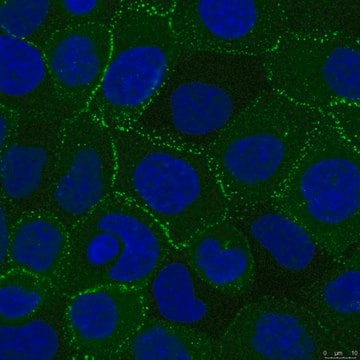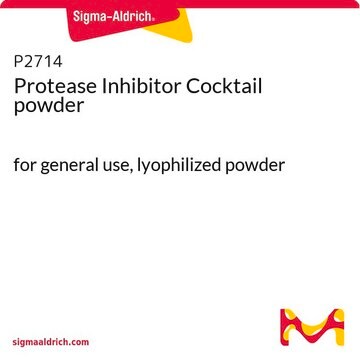R8761
Nco I from Nocardia corallina
Restriction Enzyme
Autenticatiper visualizzare i prezzi riservati alla tua organizzazione & contrattuali
About This Item
Numero CAS:
Numero MDL:
Codice UNSPSC:
12352204
Prodotti consigliati
Grado
Molecular Biology
for molecular biology
Stato
buffered aqueous glycerol solution
Concentrazione
10,000 units/mL
Condizioni di spedizione
wet ice
Temperatura di conservazione
−20°C
Cerchi prodotti simili? Visita Guida al confronto tra prodotti
Specificità
Recognition sequence: 5′-C/CATGG-3′
Cutting results: a 2-10-fold Nco I overdigestion of 1 μg λ DNA substrate results in 100% cutting
Heat inactivation: Inactivated at 65 °C for 15 minutes.
Cutting results: a 2-10-fold Nco I overdigestion of 1 μg λ DNA substrate results in 100% cutting
Heat inactivation: Inactivated at 65 °C for 15 minutes.
Applicazioni
NcoI is a DNA restriction endonuclease that is used in molecular biology applications to cleave the DNA recognition site 5′-C/CATGG-3′, resulting in DNA fragments with 5′-cohesive termini.
Altre note
Supplied with 10x Restriction Enzyme Buffer SH (B3657).
Stato fisico
Solution in 20 mM Tris-HCl, pH 8.0 , 0.1 mM EDTA, 100 mM NaCl, 10 mM 2-mercaptoethanol, 50% glycerol (v/v), 0.2%Triton X-100 (v/v) at 4 °C
Prodotti correlati
N° Catalogo
Descrizione
Determinazione del prezzo
Codice della classe di stoccaggio
12 - Non Combustible Liquids
Classe di pericolosità dell'acqua (WGK)
WGK 2
Punto d’infiammabilità (°F)
Not applicable
Punto d’infiammabilità (°C)
Not applicable
Scegli una delle versioni più recenti:
Possiedi già questo prodotto?
I documenti relativi ai prodotti acquistati recentemente sono disponibili nell’Archivio dei documenti.
E M Van Cott et al.
Gene, 74(1), 55-59 (1988-12-25)
Methyltransferase genes from the FnuDI, NaeI, NcoI, and XbaI restriction-modification systems have been isolated in Escherichia coli by 'shot-gun' cloning bacterial DNA fragments into plasmid vectors and selecting for protectively modified molecules that resist digestion by the corresponding restriction endonuclease.
Retargeting of human T cells to tumor-associated MUC1: the evolution of a chimeric antigen receptor.
Scott Wilkie et al.
Journal of immunology (Baltimore, Md. : 1950), 180(7), 4901-4909 (2008-03-21)
MUC1 is a highly attractive immunotherapeutic target owing to increased expression, altered glycosylation, and loss of polarity in >80% of human cancers. To exploit this, we have constructed a panel of chimeric Ag receptors (CAR) that bind selectively to tumor-associated
Jonathan V Reddy et al.
Molecular biology of the cell, 17(10), 4353-4363 (2006-08-04)
Mannose 6-phosphate receptors (MPRs) deliver newly synthesized lysosomal enzymes to endosomes and then recycle to the Golgi. MPR recycling requires Rab9 GTPase; Rab9 recruits the cytosolic adaptor TIP47 and enhances its ability to bind to MPR cytoplasmic domains during transport
C Kessler et al.
Gene, 92(1-2), 1-248 (1990-08-16)
The properties and sources of all known class-I, class-II and class-III restriction endonucleases (ENases) and DNA modification methyltransferases (MTases) are listed and newly subclassified according to their sequence specificity. In addition, the enzymes are distinguished in a novel manner according
TALENs and ZFNs are associated with different mutation signatures.
Yongsub Kim et al.
Nature methods, 10(3), 185-185 (2013-02-12)
Il team dei nostri ricercatori vanta grande esperienza in tutte le aree della ricerca quali Life Science, scienza dei materiali, sintesi chimica, cromatografia, discipline analitiche, ecc..
Contatta l'Assistenza Tecnica.




